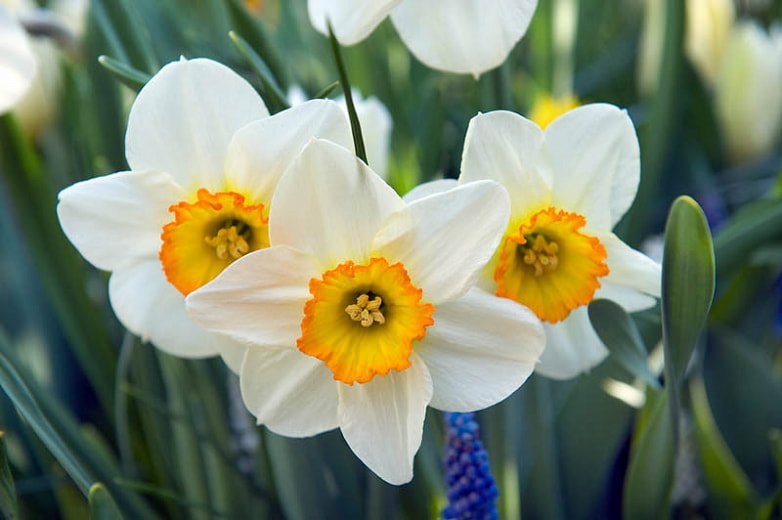Natural French Aromatherapist and Natural Perfumer Expert
These pretty spring flowers have rich, fresh, and delicate fragrances. From the green floral scent of narcissus to the sweet one of daffodils and the dizzying greener one of hyacinth, Nature deploys its olfactory treasures from spring onwards. This season is synonymous with a floral olfactory explosion that delights the senses during walks and also in the gardens: lily of the valley, violet, orange blossom, honeysuckle, magnolia, gardenia, tuberose to name the better known.
In this article, I invite you to discover not only each of these three flowers' natural fragrances but also their holistic virtues and how their voluptuous essences are extracted.
From March, the meadows are dotted with magnificent yellow flowers: daffodils. Narcissus (Narcissus spp.) or daffodils are perennial plants forming large bulbs, native to Europe and North Africa where they grow in meadows, woods and riverbanks. In fact, this pretty flower with such a shimmering color is a harbinger that spring is here. The daffodil is not only popular with gardeners; it is also one of perfumers and especially natural perfumers’ favorite, as its absolute delivers a soft, sweet, particularly floral smell. Its tenacity is quite powerful, which makes it a raw material of choice for an exclusive and exceptional perfume with an original olfactory identity.
Used in perfumery, daffodil absolute brings a soft and vaporous heart note to perfumes. Its extract is also an excellent fixer, it helps to deepen the base scents. Its essence is extracted by volatile solvent and an absolute is obtained.
The daffodil is interesting because using it in a perfume promotes self-esteem; it allows you to refocus and affirm your identity in the freedom to be yourself and follow your path. Besides, when this yellow flower appears, isn't it the first of the spring flowers that turns out to be bright yellow in color?
The narcissus appears almost at the same time as the daffodil. It comes from Central Europe, North Africa, and Asia. The main producing countries are France (in Auvergne), Morocco and Egypt. Known since Antiquity for its medicinal virtues, this flower has its name attached to mythology. It is a plant that illuminates the fields in Provence, from the Haut Var to the Verdon. It is very popular with perfumers and some varieties were even grown in the Grasse region. Currently, harvesting is done on the plateaus of Aubrac and in Auvergne.
The perfume of the narcissus is extracted by enfleurage or by CO2 extraction. There is indeed an olfactory difference between these two types of extractions. The absolute is a viscous product with a heady, tobacco, green jasmine scent. Narcissus Absolute is mainly used in luxury perfumes, to bring volume to floral and oriental accords. You can combine it with jasmine, tuberose, and solar accords with frangipani or ylang ylang Extra. The CO2 extract is a premium and rare raw material. Its olfactory portrait is green floral with a richer and more complex facet. It is closer to the complexity of the perfume of the fresh flower because many olfactory facets are present: from a spring green to honeyed and peppery opulence, between a creamy and tobacco facet.
In aromacology, breathing its perfume allows you to find hope, to see the light at the end of the tunnel, to let joy shine.
Another early spring flower that beautifully perfumes the undergrowth is the hyacinth. It is a bulbous plant of the Liliaceae family. Native to Western and Middle Eastern Asia: Turkey, Baghdad and Aleppo region, it grows from sea level up to 2,000 m altitude. It is found close to France in the south-west and south-east regions.
In Greek mythology, Apollo, God of the sun, and Zephyr, god of the west wind, compete for the affection of a young boy. At one point, Apollo teaches Hyakinthos how to throw the disc and Zephyr becomes so angry that he blows in Apollo's direction, thus sending the disc violently back towards Hyakinthos, which hits him and kills him. Heartbroken, Apollo notices a flower sprouting from the spilled blood and names it hyacinth in honor of the boy. Its starry flowers are gathered in a dense and very fragrant cluster; their scents differ according to the color of the flower. Hyacinth is highly prized by perfumers. The extraction is done by enfleurage and this absolute remains a rare and precious product (which is worth it!). Flower composed of multiple flowers and in various colors, it is almost unclassifiable. Its absolute is rare and precious. It's that or nothing! That's why you won't find this holy grail easily. Otherwise, it is a composition of odorous molecules such as indole, phenylethyl alcohol, hydroxycitronellal among others. Please note that only its bulb is toxic when used internally.
In aromacology, its fragrance harmonizes body and soul. It promotes creativity and self-expression with courage and determination.
Other flowers reveal their beautiful scents to us in Nature, in the garden to better delight our compositions, but these three are truly exceptional flowers that offer an extraordinary richness and olfactory complexity. If you want to learn how to compose, structure, and invent beautiful natural perfumes and know how to master noble ingredients, register for the spring session of French Natural Perfumery which opens its doors on April 4th.




 RSS Feed
RSS Feed